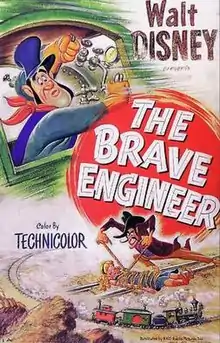The Brave Engineer
The Brave Engineer is a 1950 Walt Disney-produced animated short film,[2] based on the exploits of legendary railroad engineer John Luther "Casey" Jones.[3] It is narrated by comic Jerry Colonna and is a comedically madcap fanciful re-telling[4] of the story[5] related in the Wallace Saunders ballad, later made famous by Eddie Newton and T. Lawrence Seibert.
| The Brave Engineer | |
|---|---|
 | |
| Directed by | Jack Kinney[1] |
| Produced by | Walt Disney |
| Story by | Dick Kinney Dick Shaw |
| Based on | The Ballad of Casey Jones by Eddie Newton T. Lawrence Seibert |
| Starring | The King's Men |
| Narrated by | Jerry Colonna |
| Music by | Ken Darby |
| Animation by | Milt Kahl Fred Moore Al Bertino |
| Layouts by | Don DaGradi |
| Backgrounds by | Ray Huffine |
Production company | |
| Distributed by | RKO Radio Pictures |
Release date | March 3, 1950 |
Running time | 7 min. 38 sec. |
| Country | United States |
This short has appeared on many television programme and specials such as Walt Disney's Wonderful World of Color (1954), The Mouse Factory (1972), Good Morning, Mickey! (1983), Walt Disney Cartoon Classics (1983), DTV (1984), Disney's Sing Along Songs (1986), American Folk Heroes, Disney's Rootin' Tootin' Roundup (1990), Mickey's Mouse Tracks (1992), Donald's Quack Attack (1992), Sing Me A Story with Belle (1995), The Ink and Paint Club (1997), and the 2001 direct-to-video release, Disney's American Legends[6] It also appears on the Walt Disney Treasures set Disney Rarities - Celebrated Shorts 1920s - 1960s.[7]
Synopsis
The cartoon opens to a railroad yard where "all the trains are fast asleep." The sun rises, and engineer Casey Jones wakes from his slumber in the cab of his engine, Johnny, No. 2, an American Standard 4-4-0, that is hauling a mail car and a caboose. His train begins the journey, and Casey is intent on making his schedule, at all costs since the word "Egad!" is said multiple times. The train is repeatedly delayed along the journey. Casey has to paddle his train through flooded wetlands, stops for a cow crossing the tracks, saves a woman who was tied up on the tracks by a stereotypical villain character, gets the train across a gorge after another villain destroyed the tracks spanning it, and fights a group of criminals who had climbed onto the cab of the engine, and failed to rob the train. To make up for lost time, Casey runs his engine well past his mechanical limits, and while focusing completely on repairing Johnny, drives his train at full speed down a hill into another train being a double headed slow freight train with Zeb and Zeek, two 4-8-0 Mastodon engines both No. 77 and No. 5, who are approaching his mail train on the same track without noticing until too late when the two trains collide with a large explosion after the conductor, who runs up to tell him about the oncoming train, fails to get the message through, jumps off the train, and then is shown still standing on Johnny in the next shot, which is wide. His train is almost completely destroyed, but Casey arrives at his destination, with the remains of Johnny, just to arrive at the station, "almost on time."
Differences between the cartoon and real life
- The Brave Engineer depicts the wreck near Vaughan, Mississippi as a head-on collision with Casey's train steaming one way and another train steaming the other way, in an Ozark-like mountain range. In the real accident, Casey's engine had struck the rear end of a train, which was stopped on the tracks, due to a broken air line, and didn't occur in a mountain area.
- The accident takes place in broad daylight and clear conditions in the cartoon. The real-life wreck occurred at night during a rain storm.
- The Brave Engineer ends with Casey only mildly injured after the wreck on the remains of his damaged engine, Johnny. In real life, he was critically injured, and did not survive the accident.
- Casey operates Johnny single handed in the cartoon. Sim Webb was with Casey before the crash in real life.
- Johnny is an American Standard 4-4-0 engine in the cartoon. Casey's real engine was an American 4-6-0 engine No. 382 in real life on his fateful since No. 99 is doiled up as a replica of that engine at the Casey Jones US History Museum in Jackson, Tennessee, USA.
See also
- Make Mine Music-the 1946 package feature that featured Casey at the Bat which similar design and madcap comedic pace
- John Luther "Casey" Jones
- Casey Jones (TV series)-also a loose adaptation of the legend with Alan Hale as Casey
References
- AllMovie
- Lenburg, Jeff (1999). The Encyclopedia of Animated Cartoons. Checkmark Books. p. 153. ISBN 0-8160-3831-7.
- FilmAffinity
- Letterboxd
- MUBI
- American Legends (Video 2001) - IMDB
- Walt Disney Treasures: Disney Rarities DVD Review - DVDizzy.com